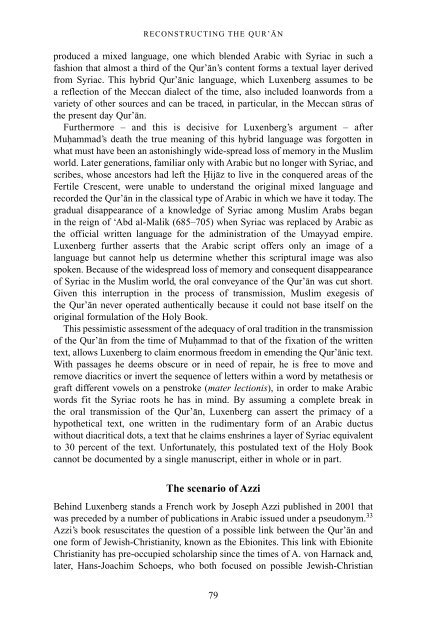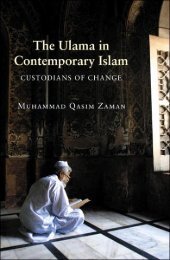The Qur'an in its historical context (pdf - Islam and Christian-Muslim ...
The Qur'an in its historical context (pdf - Islam and Christian-Muslim ...
The Qur'an in its historical context (pdf - Islam and Christian-Muslim ...
Create successful ePaper yourself
Turn your PDF publications into a flip-book with our unique Google optimized e-Paper software.
RECONSTRUCTING THE QUR’AN<br />
produced a mixed language, one which blended Arabic with Syriac <strong>in</strong> such a<br />
fashion that almost a third of the Qur’an’s content forms a textual layer derived<br />
from Syriac. This hybrid Qur’anic language, which Luxenberg assumes to be<br />
a reflection of the Meccan dialect of the time, also <strong>in</strong>cluded loanwords from a<br />
variety of other sources <strong>and</strong> can be traced, <strong>in</strong> particular, <strong>in</strong> the Meccan suras of<br />
the present day Qur’an.<br />
Furthermore – <strong>and</strong> this is decisive for Luxenberg’s argument – after<br />
Muhammad’s death the true mean<strong>in</strong>g of this hybrid language was forgotten <strong>in</strong><br />
what must have been an astonish<strong>in</strong>gly wide-spread loss of memory <strong>in</strong> the <strong>Muslim</strong><br />
world. Later generations, familiar only with Arabic but no longer with Syriac, <strong>and</strong><br />
scribes, whose ancestors had left the Hijaz to live <strong>in</strong> the conquered areas of the<br />
Fertile Crescent, were unable to underst<strong>and</strong> the orig<strong>in</strong>al mixed language <strong>and</strong><br />
recorded the Qur’an <strong>in</strong> the classical type of Arabic <strong>in</strong> which we have it today. <strong>The</strong><br />
gradual disappearance of a knowledge of Syriac among <strong>Muslim</strong> Arabs began<br />
<strong>in</strong> the reign of ‘Abd al-Malik (685–705) when Syriac was replaced by Arabic as<br />
the official written language for the adm<strong>in</strong>istration of the Umayyad empire.<br />
Luxenberg further asserts that the Arabic script offers only an image of a<br />
language but cannot help us determ<strong>in</strong>e whether this scriptural image was also<br />
spoken. Because of the widespread loss of memory <strong>and</strong> consequent disappearance<br />
of Syriac <strong>in</strong> the <strong>Muslim</strong> world, the oral conveyance of the Qur’an was cut short.<br />
Given this <strong>in</strong>terruption <strong>in</strong> the process of transmission, <strong>Muslim</strong> exegesis of<br />
the Qur’an never operated authentically because it could not base <strong>its</strong>elf on the<br />
orig<strong>in</strong>al formulation of the Holy Book.<br />
This pessimistic assessment of the adequacy of oral tradition <strong>in</strong> the transmission<br />
of the Qur’an from the time of Muhammad to that of the fixation of the written<br />
text, allows Luxenberg to claim enormous freedom <strong>in</strong> emend<strong>in</strong>g the Qur’anic text.<br />
With passages he deems obscure or <strong>in</strong> need of repair, he is free to move <strong>and</strong><br />
remove diacritics or <strong>in</strong>vert the sequence of letters with<strong>in</strong> a word by metathesis or<br />
graft different vowels on a penstroke (mater lectionis), <strong>in</strong> order to make Arabic<br />
words fit the Syriac roots he has <strong>in</strong> m<strong>in</strong>d. By assum<strong>in</strong>g a complete break <strong>in</strong><br />
the oral transmission of the Qur’an, Luxenberg can assert the primacy of a<br />
hypothetical text, one written <strong>in</strong> the rudimentary form of an Arabic ductus<br />
without diacritical dots, a text that he claims enshr<strong>in</strong>es a layer of Syriac equivalent<br />
to 30 percent of the text. Unfortunately, this postulated text of the Holy Book<br />
cannot be documented by a s<strong>in</strong>gle manuscript, either <strong>in</strong> whole or <strong>in</strong> part.<br />
<strong>The</strong> scenario of Azzi<br />
Beh<strong>in</strong>d Luxenberg st<strong>and</strong>s a French work by Joseph Azzi published <strong>in</strong> 2001 that<br />
was preceded by a number of publications <strong>in</strong> Arabic issued under a pseudonym. 33<br />
Azzi’s book resuscitates the question of a possible l<strong>in</strong>k between the Qur’an <strong>and</strong><br />
one form of Jewish-<strong>Christian</strong>ity, known as the Ebionites. This l<strong>in</strong>k with Ebionite<br />
<strong>Christian</strong>ity has pre-occupied scholarship s<strong>in</strong>ce the times of A. von Harnack <strong>and</strong>,<br />
later, Hans-Joachim Schoeps, who both focused on possible Jewish-<strong>Christian</strong><br />
79



